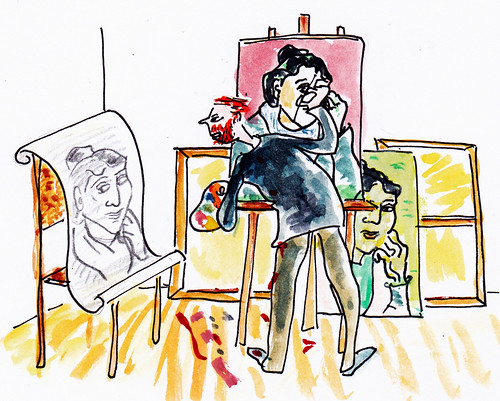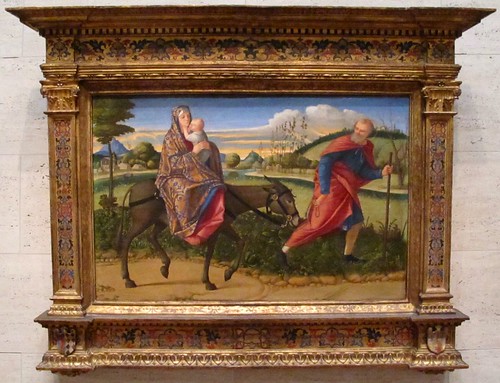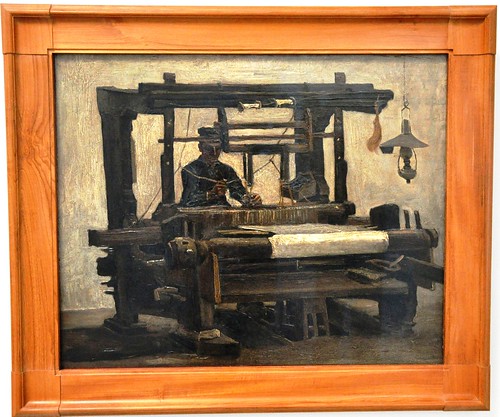Posts Tagged ‘Vincent’
euronews le mag – Vincent van Gogh’s works focus of new exhibition
www.euronews.net The works of Dutch artist Vincent van Gogh are at the heart of a new exhibition currently on display at Genoa’s Palazzo Ducale. The paintings and drawings reflect the journey of the artist who died at the early age of 37 and who suffered bouts of mental illness. The exhibition is also showing one of the most famous works in art history, Paul Gauguin’s renowned painting “Where do we come from? Who are we? Where are we going?”
Recommend : Personal Transporter. At Segway Brick Mailbox
7 Interesting Facts About Vincent Van Gogh

The following 7 interesting facts are taken from historical records and are not biased opinions.
1) Fell in Love with his Landlady’s Daughter in Hague
It seems that Vincent Van Gogh had a penchant for the ladies, and one of his first jobs was in an office in the City of Hague. he worked at this job for over four years until he fell in love with his landlord’s daughter and was subsequently dismissed from the company. This demonstrates Van Gogh‘s quest for love even at the expense of monetary concerns.
2) He Forever Searched for Happiness
Vincent Van Gogh was a man possessed with the notion that happiness was all that he required in this world. Far be it for anyone to argue that point, yet what is true is that he forever chased that emotion, and came up empty in the end. This craving of happiness can be seen in all of his artistic endeavors.
3) He Suffered from Schizophrenia and Other Mental Health Problems
Suffering from mental disorders such as schizophrenia affected Van Gogh his entire life and artistic career. The fabled ‘Starry Night’ rendition was actually done when he was a resident in an insane asylum in Saint-Remy, France. Many other mental disorders plagued this fantastic artist his entire life and can be easily picked out, in some of his most famous artistic pursuits. As an intelligent individual and famed artist, Vincent Van Gogh knew when to say when and admitted himself many times into mental institutions all throughout Europe. After being released from such self-imposed institutions of recovery, he showed signs of increasing improvement but these were fleeting at best. In the end, he took his own life, after a bout of depression.
4) He Loved Japanese Artistry
The island of Japan mesmerized Van Gogh and showed in many of his paintings with cherry blossoms and other Japanese iconic artistry. Some of his best works are Japanese-themed and Pacific Island related.
5) He Loved his Brother Theo
There was no denying this, Vincent Van Gogh‘s love for his brother Theo, translated both time and space and life and death. Everything that he accomplished was directly attributed to his brother Theo, even when his brother had little or nothing to do with the accomplishment. He would often speak of his brother in the highest regard and say a finer brother a man could never have.
6) He Only Sold One Painting During His Lifetime
Vincent Van Gogh created 2000 pieces of art, 900 paintings and 1100 sketches and pencil drawings. Of those entire great works only one was sold for profit.
7) His Brother Theo’s Wife Is Actually Responsible For His Popularity Today
Six months after Vincent died, Theo died, and his wife Johanna devoted the rest of her life to getting Van Gogh the recognition she felt he rightly deserved. If it was not for her efforts, the world may not have known of Vincent‘s mastery.
My Links : Personal Transporter. At Segway SugarDecor welcomeholidayservice
Starry Night by Vincent Van Gogh

Starry Night by Van Gogh is a great oil painting which has left a great legacy on the art world and led to many further activities in it’s honour such as compositions by great musicians, personal tattoos and all sorts of other bizarre but respectful acts honouring Vincent‘s masterpiece. This article covers this work in good detail for your interest.
Sadly the Starry Starry Night is not one of Vincent‘s most favoured paintings as he revealed in several letters which he sent to brother Theo, an art gallery owner and dealer. In these he explained that the painting actually was to accurate to the real view that he experienced himself, rather than incorporating the artist’s own emotions and style. Few nowadays will understand or agree with that opinion as the work seems to ooze his natural flair and style, plus make a great use of his bright, bold colour schemes. So for others, this is one of his best paintings and it retains great popularity across the world.
The work was produced during the day as Van Gogh worked entirely from his memories in conjunction with what he could see from his daily view as he painted. Vincent produced another version of the work afterwards with a pen sketch offering a different feeling to the work, bringing a far simpler alternative with more subdued colours. The original oil on canvas with it’s vivid colour scheme is clearly always going to be the best known and most popular version for those looking to buy prints or posters to add some colour to their homes and offices.
Visit : Personal Transporter. At Segway welcomeholidayservice /aerobed/
Vincent Van Gogh Sunflowers Floral Picture Framed Art Print
Vincent Van Gogh Sunflowers Floral Picture Framed Art Print Review
Vincent Van Gogh Sunflowers Floral Picture Framed Art Print Feature
- Framed Art is Brand New
- Framed Art measures 10×12 inches Art Print measures 8×10 inches
- Solid Wood Frame, Real Glass Front
- Custom Finished and Expertly Crafted
- Comes Ready To Hang
Vincent Van Gogh Sunflowers Floral Picture Framed Art Print Overview
This beautiful framed art goes well in any room. Artwork and frame are manufactured in the United States by Art Prints Inc. using quality materials such as premium grade A solid hardwood, tempered picture frame glass, and high quality acid free lithograph art paper.
Available at Amazon See Complete Specs and Reviews More
*** Product Information and Prices Stored: Nov 08, 2010 09:16:39
Visit : Personal Transporter. At Segway Mailbox American Mailbox welcomeholidayservice
Almond Blossom Poster Print by Vincent van Gogh, 36×24
Almond Blossom Poster Print by Vincent van Gogh, 36×24 Review

i ordered my poster from newbury comics… and it was EXACTLY what it said it was, no text on the poster, poster quality paper, no wrinkles… excellent shipping time and condition. newbury comics is great, and the poster is too!
Almond Blossom Poster Print by Vincent van Gogh, 36×24 Feature
- Print Title: Almond Blossom
- Artist: Vincent van Gogh
- Size: 36 x 24 inches
Almond Blossom Poster Print by Vincent van Gogh, 36×24 Overview
Decorate your home or office with high quality posters. Almond Blossom is that perfect piece that matches your style, interests, and budget.
Available at Amazon See Complete Specs and Reviews More
*** Product Information and Prices Stored: Oct 30, 2010 22:14:24
See Also : Personal Transporter. At Segway Painting Instructional Thai Food Good Health American Mailbox Mailbox
Vincent Van Gogh – Great Painter & Self Multilator

Image : http://www.flickr.com
Famous for cutting off his ear, or were his paintings really that good?
Early Years
Vincent Willem van Gogh was born March 30, 1853, in Zundert, a small village in the Netherlands, to Anna Cornelia Carbentus and Theodorus van Gogh. He had two younger brothers, Theodorus, who became particularly important in his life, and Cor, as well as three sisters, named Elizabeth, Anna and Wil. His father was a minister of the Dutch Reform Church.
After an unsuccessful run as an art dealer in Great Britain, Vincent found himself turned towards religion, and pursued a life as a missionary for several years. Eventually, giving into pressure from his family, he joined his parents in Etten in the Netherlands. He was quickly overcome by wanderlust, however, and soon left again to pursue his art, scrapping by a meager existence as he traveled from place to place. During this time he began to develop the ill health that would plague him for the rest of his life.
Paris and After
In 1886 Vincent joined his brother Theo in Paris, with whom he had maintained a steady correspondence throughout his earlier life. It was here that he seriously committed himself to art, and studied at the studio of Fernand Cormon, and encountered Impressionistic artists such as Gaugin, Monet, and Pissarro. Vincent‘s personally style underwent a drastic change at this time, turning away from the darker palette of his earlier work such as The Potato Eaters. Instead, he began to employ the short, thick brushstrokes, and bright, vivid colors for which he is most well known today. It was only then, in the last four years of his life, that he created the majority of his body of work, over 200 paintings.
Eventually, he left Paris for Arles, where he hoped to found an art school. He was eventually joined by Gaugin, but the two increasingly quarreled. During an especially tense moment, Vincent cut off a portion of his left ear with a razor blade. Suffering increasingly ill mental and physical health, he was confined to an asylum in Saint-Remy for treatment, where he was visited by his brother Theo. There, some of his work became characterized by bold whorls and waves, including one of his most famous paintings, The Starry Night.
Death
In May of 1890, Vincent left Saint-Remy and moved to Auvers-sur-Oise. There he was cared for by one Dr. Gachet, who became the subject of another of van Gogh‘s most revered pieces, Portrait of Dr. Gachet. His depression worsened, and on July 27, 1890, he shot himself in the chest. He died two days later, at the age of 37. His last words, as reported by his brother Theo, who stayed by his deathbed, were “La tristesse durera toujours” (French for “The sadness will last forever”). During his brief career, Vincent had only sold one painting, The Red Vineyard, and traded one other as a substitute for rent payment.
Legacy
Vincent van Gogh, despite his lack of success during his own lifetime, had gone on to be one of the most influential painters of all time. While partially fuelled by the publishing of his correspondence with Theo, which created his image of a tormented artists dedicated to his passion, the vibrancy and texture of his work influenced the aesthetic of many painters after him. His paintings are incredibly popular among collectors; one of the two versions of Portrait of Dr. Gachet was sold in 1990 $82.5 million, at the time the highest price ever for a single painting. Today, van Gogh and his work represents one of the most recognized and influential icons of art.
Born: March 30, 1853
Died: July 29, 1890
Famous For: Painting, drawing, ushering in Post-Impressionistic art, cutting off part of his left ear.
Key Accomplishments: Furthered aesthetic development of Impressionism into Post-Impressionism, posthumously recognized as one of the world’s greatest artists.
Significant Quote: “I tell you, if one wants to be active, one must not be afraid of going wrong, one must not be afraid of making mistakes now and then. Many people think that they will become good just by doing no harm- but that’s a lie, and you yourself used to call it that. That way lies stagnation, mediocrity.” (Letter to Theo van Gogh, from Nuenen)
Fun Quote: “Poetry surrounds us everywhere, but putting it on paper is, alas, not so easy as looking at it.”
Recommend : Free Online Advertising history Book of Art Personal Transporter. At Segway Mailbox
Analysis of The Night Cafe – Vincent van Gogh

Image : http://www.flickr.com
Vincent‘s Two Cafes
“I often think that the night is more alive and more richly colored than the day.” Vincent van Gogh
Van Gogh‘s two ultra-famous café scenes comprise a study in opposites. Though both paintings employ Vincent‘s famous bold and furious brushstrokes and striking colors, the two pictures feel entirely different. One, “Café Terrace at Night,” is lovely and full of a frothy light, a night scene with stars outside the café on the Place de Forum. The other, “Night Café,” is, in the artist’s own words, “…one of the ugliest I have ever done,” a collection of clashing colors in the dreariest atmosphere.
Both paintings were made in Arles after van Gogh had lived and studied in Paris, and met various French impressionists. His own style became much lighter, less moralistic and more rife with color.
“Night Café” depicts the interior of a pool in Arles’ Place Lamartine. A more striking van Gogh canvas would be difficult to find, but no one could call this particular picture beautiful. It was the artist’s intention to show the lowest edge of humanity, without adornment, with as much impact and sincerity as possible.
There is no doubt he succeeded. Upon first glance, the viewer almost tends to glance away, as if burned. Fully two-thirds of the painting is the floor of the café, executed in sulphuric yellow with exaggerated lines of perspective that yank the eye into the painting. Next, a green billiard table, outlined in heavy black, stops us cold. Beside the table stands a figure in a light-colored coat, staring out at us without expression.
“I have tried to express the terrible passions of humanity by means of red and green,” van Gogh wrote. Yellow walls give on to blood-red walls that lead to an obtrusive green ceiling, and lining the walls are the locals at the bar tables, hunched over in late-night stupor. Lamps hang from the ceiling, surrounded by Vincent‘s wheels of curving yellow strokes.
A stark black and white clock depends in the background, impossible to miss. It is almost a quarter past midnight in this desolate scene. “Night Café” is one of Vincent‘s most powerful communications through art of the human condition and human emotions.
The other van Gogh café painting, “Café Terrace at Night,” shows the exterior of a café which still stands in Arles, though it was renamed The van Gogh Café and remodeled to closely resemble the painting which immortalized it. He painted this work in a flurry, using many of the same techniques he employed in his drawings. This is one of his most beautiful paintings, full of the light and peace he sought, but never found.
Perspective and warm complementary colors draw the viewer into the painting and beyond. The graphic texture of the street’s cobblestones invite the eye toward the little café itself, with its tiny white tables on the street, repeating the spheres of Vincent‘s stars hung in the Prussian blue sky. The awning and walls of the café, warm yellow, cut into the sky to enhance both colors and form the main composition.
Van Gogh loved the night. He writes, “I have a terrible need of–dare I say–religion…then I go outside at night and paint the stars.” He painted this night scene on the spot, at night, using no blacks. His father was a preacher and Vincent went into the ministry for a while. It was later that this artist, now a star himself posthumously, decided his ministry would be to find a way to give hope and consolation to humanity through his art.
Thanks To : Scubaequipment welcomeholidayservice
